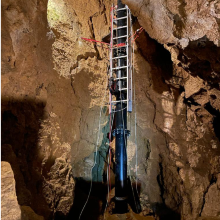New publication, published in Geosciences (MDPI). The work has been developed in the framework of the SFB 1313 vision topic on "calcite dissolution", the LH2 project on density-driven dissolution of CO2, and the SimTech project on coupling flow, transport, and geochemical processes in subsurface fractured media.
Authors
- Holger Class (University of Stuttgart, SFB 1313 research project C04)
- Leon Keim (University of Stuttgart)
- Larissa Schirmer (University of Stuttgart)
- Bettina Strauch (Helmholtz-Zentrum Potsdam)
- Kai Wendel (University of Stuttgart)
- Martin Zimmer (Helmholtz-Zentrum Potsdam)
Abstract
Dissolved CO2 in karst water is the key driving force of karstification. Replenishment of CO2 concentrations in karst water occurs by meteoric water that percolates through the vadose zone, where CO2 produced from microbial activity is dissolved. CO2 can thus be transported with the percolating water or in the gas phase due to ventilation in karst systems. We measured seasonally fluctuating CO2 concentrations in the air of a karst cave and their influence on aqueous CO2 concentrations in different depths of a stagnant water column. The observed data were compared to numerical simulations. The data give evidence that density-driven enhanced dissolution of gaseous CO2 at the karst water table is the driving force for a fast increase of aqueous CO2 during periods of high gaseous concentrations in the cave, whereas during periods of lower gaseous concentrations, the decline of aqueous CO2 is limited to shallow water depths in the order of 1 m. This is significant because density-driven CO2 dissolution has not been previously considered relevant for karst hydrology in the literature. Attempts at reproducing the measured aqueous CO2 concentrations with numerical modeling revealed challenges related to computational demands, discretization, and the high sensitivity of the processes to tiny density gradients.

Holger Class
apl. Prof. Dr. Ing.Project Leader, Research Project C04, Central Project Z


